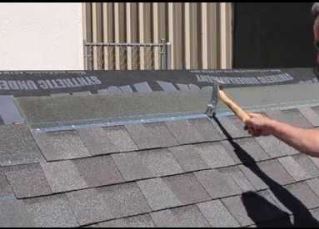Roofing is a crucial aspect of every home, and one question that often arises during roof installation or repair is, “How many nails per shingle should I use?” This seemingly simple query has a significant impact on the structural integrity and longevity of your roof. In this comprehensive guide, we’ll delve into the specifics of nailing shingles, offering expert advice and practical tips.
How Thick Is a Shingle?

Shingles come in various thicknesses depending on the material and type. The most common type of residential roofing shingle is the asphalt shingle, which typically comes in two thicknesses:
- Three-Tab Shingles: These are the thinner and more lightweight option, with a standard thickness of around 20 to 25 years. They are cost-effective but may not be as durable as thicker alternatives.
- Architectural or Dimensional Shingles: These are thicker and more durable, with a standard thickness of 30 to 40 years or more. They are heavier and often have a more textured appearance, providing added dimension to your roof.
Keep in mind that other roofing materials like wood shingles, metal roofing, or slate shingles have different thicknesses, and their durability and appearance can vary widely. When choosing roofing materials, it’s essential to consider factors like climate, budget, and desired aesthetics in addition to thickness.
Do You Need 4 or 6 Nails per Shingle?
- For asphalt shingles, it’s typically recommended to use four nails per shingle to ensure a secure hold.
- If you’re working with wood shingles or shakes, two nails per shingle are often sufficient, but always check the manufacturer’s guidelines.
- In areas prone to extreme weather conditions or where local building codes require it, using more nails, such as six per shingle, can provide added stability and prevent shingle lift-off.
It’s crucial to consult with a roofing professional or your local building department to determine the specific requirements for your region and roofing material to ensure your roof is properly secured and complies with safety standards.
How Many Nails per Shingle

When it comes to fastening shingles to your roof, precision is key. The optimal number of nails per shingle can vary depending on several factors, including the type of shingle, climate, and local building codes. Guidelines to help you make an informed decision:
- Roofing Material Matters
Different roofing materials require different nailing techniques. For asphalt shingles, which are the most common roofing material, it’s recommended to use four nails per shingle. This ensures a secure hold, even in high winds.
- Wood Shingles and Shakes
If you’re working with wood shingles or shakes, you’ll typically use two nails per shingle. However, always check the manufacturer’s recommendations, as they may have specific guidelines for their products.
- Climate Considerations
In areas prone to strong winds, hurricanes, or other extreme weather conditions, using more nails per shingle is advisable. Extra nails provide added stability and prevent shingle lift-off.
- Local Building Codes
Local building codes often dictate the minimum number of nails required per shingle. These codes are in place to ensure the safety and durability of roofs in specific regions. Be sure to consult your local building department or a roofing professional to understand these requirements.
- Nail Placement
Proper nail placement is as crucial as the quantity. Nails should be driven in the designated nailing zone, typically just above the shingle cutout. Avoid overdriving or underdriving nails, as this can compromise the shingle’s integrity.
What Is the Best Nail Pattern for Shingles?
The best nail pattern for shingles depends on the type of shingle you’re using and the local building codes in your area. Here are some general guidelines:
- Asphalt Shingles: For standard asphalt shingles, a common nail pattern is to place nails near the center of the shingle, just above the shingle cutout. The exact nail placement may vary by manufacturer, so it’s crucial to follow the specific guidelines provided with the shingles.
- Wood Shingles and Shakes: When installing wood shingles or shakes, it’s typical to use two nails per piece. One nail should be driven near the top of the shingle, while the other should be near the bottom. This helps secure the shingle firmly in place.
- Local Building Codes: Always consult your local building codes before determining the nail pattern. Building codes may specify the number of nails per shingle, their placement, and other requirements to ensure the roof’s structural integrity and safety. Building codes vary by location, so it’s essential to comply with your local regulations.
- High-Wind Areas: In regions prone to high winds or severe weather, it’s often recommended to use additional nails per shingle. Extra nails help prevent shingle lift-off during storms and contribute to the roof’s stability.
- Manufacturer Guidelines: Manufacturers of roofing materials typically provide specific recommendations for nail patterns and placement. It’s crucial to follow these guidelines to ensure warranty coverage and the best performance of the roofing material.
The best nail pattern for shingles depends on the type of shingle, local building codes, and weather conditions in your area. Always follow the manufacturer’s recommendations and consult with a roofing professional to ensure your roof is properly installed and meets safety standards.
Frequently Asked Questions
Can I use fewer nails to save money on my roofing project?
While using fewer nails may save you money in the short term, it can lead to premature roof failure. It’s best to follow manufacturer recommendations and local building codes for your region.
Should I hand-nail or use a nail gun for roofing?
Both methods can be effective if done correctly. However, hand-nailing allows for better control and reduces the risk of overdriving nails, which can damage shingles.
What should I do if I live in an area with extreme weather conditions?
In regions prone to severe weather, consider using more nails per shingle and investing in higher-quality, impact-resistant shingles to ensure your roof’s longevity.
Can I reuse shingles if I need to replace them?
Reusing shingles is generally not recommended, as it can compromise their integrity. It’s best to use new shingles for replacement projects.
Are there any eco-friendly roofing options that require fewer nails?
Yes, some eco-friendly roofing materials, like metal and rubber, may require fewer nails due to their durability and design. Consult the manufacturer’s guidelines for specific recommendations.
Is it possible to add more nails to an existing roof for extra reinforcement?
Adding nails to an existing roof can be challenging and may not provide the desired reinforcement. If you have concerns about your roof’s stability, it’s best to consult a professional roofer.
Conclusion
Securing shingles with the correct number of nails is essential for the longevity and durability of your roof. By considering factors such as roofing material, climate, and local building codes, you can make informed decisions that ensure your roof withstands the test of time. Remember that proper nail placement and technique are just as crucial as the quantity of nails used. If in doubt, consult a roofing professional to ensure your project meets safety standards and industry best practices.

